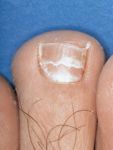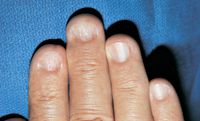- General Dermatology
- Eczema
- Chronic Hand Eczema
- Alopecia
- Aesthetics
- Vitiligo
- COVID-19
- Actinic Keratosis
- Precision Medicine and Biologics
- Rare Disease
- Wound Care
- Rosacea
- Psoriasis
- Psoriatic Arthritis
- Atopic Dermatitis
- Melasma
- NP and PA
- Skin Cancer
- Hidradenitis Suppurativa
- Drug Watch
- Pigmentary Disorders
- Acne
- Pediatric Dermatology
- Practice Management
- Prurigo Nodularis
Article
Tip: Treating brittle nails: Simple solutions work for this common problem, one dermatologist says
The current theory about brittle nails is that the condition is due to a decrease in water content and water retention of the nail plate, an expert says. Treatment includes educating patients and using inexpensive, over-the-counter products.

Key Points

The problem, according to one dermatologist who has written more than 200 peer-reviewed articles on the topic of nails, is most common among women, although men can have brittle nails, too.
"The only prevalence study was done many years ago on women, and it suggested that about 20 percent of women suffer from brittle nails," says Richard K. Scher, M.D., a nail specialist and professor of dermatology at the University of North Carolina, Chapel Hill, N.C.
Why are they brittle?

The current theory about the cause is that nails become brittle because of decreases in water content and water retention of the nail plate.
"We do know that brittle nails are more common among patients with underactive thyroids, as well as people whose occupations require frequent hand washing and use of soaps and detergents. The soaps and detergents dry out the nails," Dr. Scher tells Dermatology Times.
Removing nail polish too frequently can also cause brittleness, but it's not the nail polish itself that causes the problem.

Even acrylic nails are OK, according to Dr. Scher. Women only run into problems when they keep the acrylics on for too long.
"There is a tendency for women to keep acrylics on for extended periods of time, and when you do that, it can cause an accumulation of moisture under the nail, because acrylics are occlusive.
"The transfer of water back and forth across the nail is prevented, so moisture can accumulate under the nail, and after a period of time, that can set up a focus for fungus infection," Dr. Scher says.
Dr. Scher recommends that patients remove acrylic nails at least once every three months, then leave them off for a couple of weeks before reapplication.
Dry or cold climates can dry out nails as well. Nails are less brittle in humid conditions, because the air's moisture increases the water content of the nails and slows the evaporation from the nail plate.
Excessive sun exposure can also precipitate the problem, because it dries out the nail, as it does the skin, Dr. Scher says.
Treatment
Part of treatment is educating patients how to avoid brittle nails. If patients cannot avoid using detergents and soaps, or if they work in professions where their nails take a beating, they should use protective gloves.
Actual treatments are not new, according to Dr. Scher.
"The idea is to rehydrate the nail plate and try to keep in the moisture," he says.
Dr. Scher recommends that patients apply moisturizers (any inexpensive brand) to their hands.
In order to see results, he says, they must use the moisturizers regularly. Other potential treatments are topical urea and lactic acid creams, which, when used daily, help the nail plate to retain moisture.
The use of over-the-counter nail hardeners or nail strengtheners has mixed results, according to Dr. Scher. Some of these products contain very small amounts of acrylic, which can help strengthen the nails. But some of these products also contain formaldehyde, a nail solvent that causes dehydration.
Patients who use formaldehyde-containing products think their nails are getting stronger with initial use, but their nails will separate over time because of the formaldehyde. In addition, some women are allergic to formaldehyde.
Biotin, a B vitamin, has been shown to improve brittle nails when taken in high doses. Dermatologists, Dr. Scher says, should guide their patients in determining a safe high dose.
"Having brittle nails is a common and very treatable condition. Be sure to send the message to your patients that nails are not screwdrivers, scrapers or tools," Dr. Scher says.





